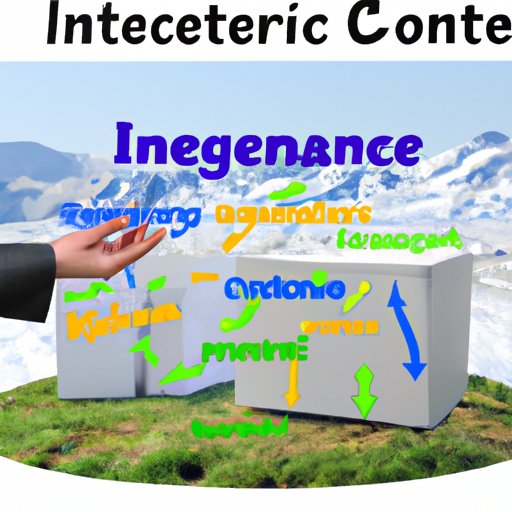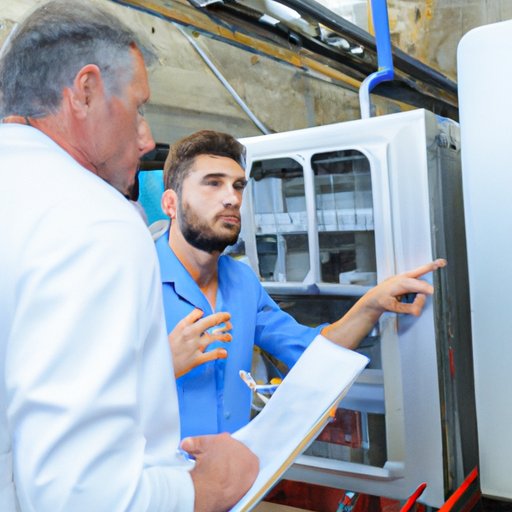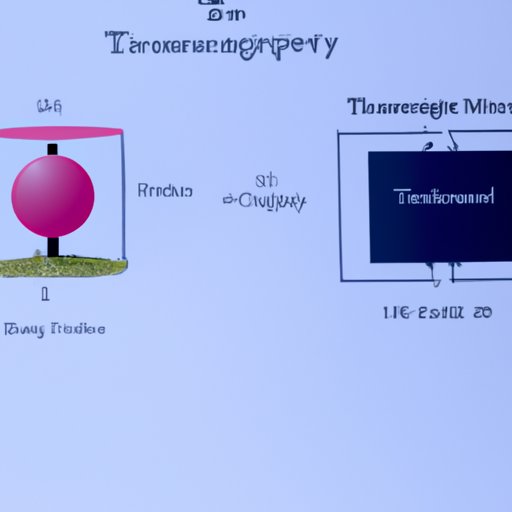Introduction
Refrigeration is defined as the process of cooling or freezing an area or object to a temperature below that of its surroundings. This process can be used for a variety of purposes, from preserving food to cooling entire buildings. In this article, we will explore how refrigeration works, examining the science and physics behind it and discussing the various benefits of refrigeration in the home and on the environment.
Explaining the Refrigeration Process Step by Step
At the heart of a typical refrigeration system is the refrigeration cycle. This cycle is composed of four main components: a compressor, an expansion valve, two heat exchangers, and a refrigerant. The compressor compresses the refrigerant, which increases its temperature and pressure. The compressed refrigerant then passes through the expansion valve, which reduces its pressure, causing it to cool. The cooled refrigerant then passes through the evaporator, where it absorbs heat from the area being cooled. Finally, the refrigerant passes through the condenser, where it releases the heat it absorbed earlier, before returning to the compressor to start the cycle again.
The type of refrigerant used in a system is important, as different kinds have different properties. Commonly used refrigerants include chlorofluorocarbons (CFCs), hydrochlorofluorocarbons (HCFCs), and hydrofluorocarbons (HFCs). These chemicals are non-toxic, non-flammable, and have a low boiling point, which makes them effective at transferring heat away from an area. The compressor is responsible for compressing the refrigerant and increasing its temperature and pressure. It is powered by an electric motor, and is the key component in the refrigeration cycle.
The expansion valve plays an important role in the cycle, as it is responsible for reducing the pressure of the refrigerant, which causes it to cool. Heat exchangers are also essential components of the cycle. The evaporator absorbs heat from the area being cooled, while the condenser releases the heat absorbed earlier. Both of these components are necessary for efficient heat transfer.
Investigating the Science and Physics Behind Refrigeration
At the core of how refrigeration works are the principles of thermodynamics. According to the first law of thermodynamics, “energy cannot be created or destroyed, only transferred or transformed.” This means that energy must be added to a system in order for it to become colder. Heat is transferred from the area being cooled to the refrigerant, which absorbs the heat and carries it away. The second law of thermodynamics states that when energy is transferred, some of it is always lost as waste. This is why proper insulation and efficient design are so important in a refrigeration system.
Heat transfer is another important concept in understanding how refrigeration works. Heat always moves from warmer areas to cooler ones, and this is the basis of the refrigeration cycle. As the refrigerant passes through the evaporator, it absorbs heat from the area being cooled. The heat is then carried away by the refrigerant, which is released in the condenser. This process is repeated over and over, allowing the system to effectively cool the area.

Discussing the Benefits of Refrigeration in the Home
Refrigeration has numerous benefits in the home. One of the most important is its ability to preserve food. By keeping food cold, refrigeration slows down the growth of bacteria and other microorganisms that can cause spoilage and illness. This allows us to keep food fresh for longer periods of time, reducing waste and saving money.
Refrigerators also provide convenience in the home. They allow us to store perishable items such as milk and eggs without having to worry about them spoiling. This makes meal preparation easier, as ingredients are always readily available. Refrigerators also help us save time by eliminating the need to run to the store every few days for groceries.
Finally, refrigerators can help us save money. By keeping food fresher for longer periods of time, refrigerators reduce the amount of food that needs to be thrown away due to spoilage. This can add up to significant savings over time.

Analyzing the Impact of Refrigeration on the Environment
Refrigeration has both positive and negative impacts on the environment. On the one hand, refrigeration systems reduce the amount of food waste, thus helping to conserve resources. On the other hand, refrigerants used in refrigeration systems can be damaging to the environment if released into the atmosphere. CFCs, HCFCs, and HFCs all have high global warming potentials and can contribute to ozone depletion.
To reduce the environmental impact of refrigeration, it is important to ensure that refrigerants are properly recycled and disposed of. Additionally, it is important to use energy-efficient designs and insulation materials in refrigeration systems to minimize energy consumption and pollutant emissions.

Examining the History of Refrigeration and Its Development
The history of refrigeration dates back to the early 1800s, when scientists began experimenting with ways to cool air using ice. In 1834, American inventor Jacob Perkins developed the first mechanical refrigerator, and in 1876, German engineer Carl von Linde invented the first commercial refrigeration system. Since then, refrigeration technology has advanced significantly. Modern refrigeration systems are much more efficient than their predecessors, and new technologies such as variable speed compressors and inverter drives have improved energy efficiency even further.
Today, refrigeration is used for a wide variety of applications, from preserving food to cooling entire buildings. Refrigeration technology continues to evolve, and new innovations such as natural refrigerants and smart controls are making refrigeration systems more efficient and environmentally friendly.
Conclusion
In conclusion, refrigeration is an important technology that has numerous benefits in the home and on the environment. At its core, refrigeration relies on the principles of thermodynamics and heat transfer. Refrigerants play an important role in the refrigeration cycle, and it is important to ensure that they are properly recycled and disposed of to minimize environmental impact. Finally, refrigeration technology has come a long way since its invention in the early 1800s, and modern refrigeration systems are much more efficient and cost-effective than their predecessors.
(Note: Is this article not meeting your expectations? Do you have knowledge or insights to share? Unlock new opportunities and expand your reach by joining our authors team. Click Registration to join us and share your expertise with our readers.)
